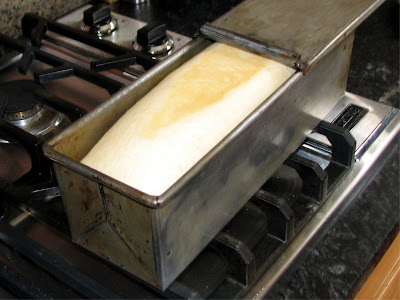
I didn't get around to baking anything this weekend, but, fortunately, as a state employee I get President's Day off. Pondering what bread to bake next, I was looking through more whole grain breads when I said to myself, Hmmph. I want white bread. So I made really white bread. Not only does it have white flour, but it also has potato flour and milk and powdered milk. All manner of white things.
You can call this sandwich bread if you want. But you can also call it pain de mie , which sounds ever so much better and more hoity-toity than white sandwich bread. The recipe is from King Arthur's website, and I chose it because I had some potato flour that I've had for a while and is probably getting to the point where I should either use it up or throw it out. Before I started baking bread, I thought flour lasted forever, so I would have had no qualms about using 20-year old flour (not, I hasten to add, that the potato flour is anywhere close to that), but now I wouldn't dream of doing such a thing.
I had to do quite a bit of searching to find my old pain de mie pan. I got the pan used on eBay.com during the period that I was buying a lot of baking equipment. I remember balking at the purchase of a new pain de mie pan. They're quite expensive, and I figured that I'd never use it again, so I could only bring myself to spend a few dollars, plus shipping. I fell in love with it when it arrived--it's heavy and tall and looks very French.

This is an easy bread to mix up, except that my friend June put a curse on me. We went out for dinner on Saturday--June and I, and our husbands too--and at some point June asked me if the bread I made with the dough hook turned out grainier than the dough I kneaded by hand. I looked at her as if I didn't know what she was talking about (because I didn't), and said I had never noticed such a thing. And, I said, it doesn't make sense because the dough hook kneads more thoroughly than you can knead by hand. But this dough turned out to have little lumps in it. Because that's never happened before, I can only think that it's June's fault, and that she must have put a hex on me or my dough hook. At first I thought there were only a few little lumps, and I tried to carefully pick them out by hand, but then I saw that there were many. If I don't blame June, I blame the potato flour for forming what looked like little mashed potato lumps.

I love baking in this lidded loaf pan! The top presses down on the bread while it's baking, so it turns out almost square. I think that the idea is that the crumb becomes more compressed this way, which is why it's called pain de mie, which means bread of crumb, more or less. I grew up thinking it was called a Pullman loaf, which is not as French or romantic. I could look up why it's called that (because it was served on a Pullman car?), but I think I'll leave that for another time.
I was feeling a little insecure about this bread, because of the lumps and all, so I decided to make up for the lumps by taking its temperature so at least the bread's lumps would be the proper temperature.

The trouble with sticking the thermometer in the middle of the bread is that it leaves a hole. I don't like the idea of a hole in the middle of the bread, which is why I don't usually do it, and it turned out to be 190 degrees on the first testing, so it was a letdown anyway.
For a plain white loaf, this is seriously good bread. The little potato-y lumps that I was so concerned about disappeared in the baking, leaving nothing in their wake but a fine, delicate crumb. I didn't make sandwiches, but it's clear that this bread would be perfect for sandwiches, and even better for grilled sandwiches. It will probably make excellent toast, a hypothesis which I will test tomorrow morning. And yet...I have to admit that this plain white bread, good as it is, just doesn't have the complexity of the whole wheat bread which I've been dissing. The lesson seems to be--enjoy the bread you're eating now.


















